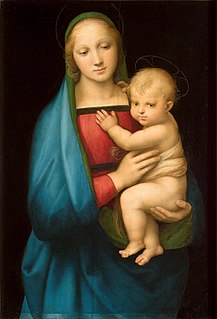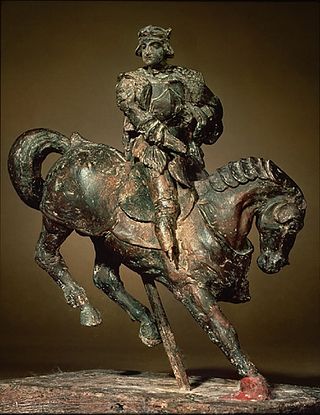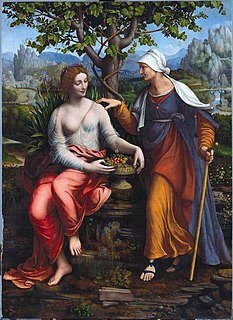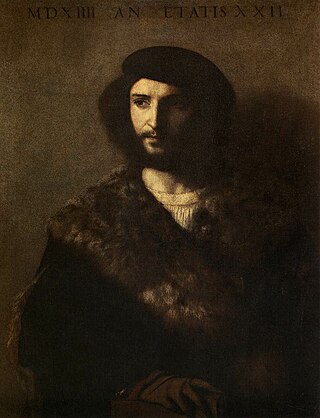
Leonardo di ser Piero da Vinci was an Italian polymath of the High Renaissance who was active as a painter, draughtsman, engineer, scientist, theorist, sculptor, and architect. While his fame initially rested on his achievements as a painter, he also became known for his notebooks, in which he made drawings and notes on a variety of subjects, including anatomy, astronomy, botany, cartography, painting, and paleontology. Leonardo is widely regarded to have been a genius who epitomized the Renaissance humanist ideal, and his collective works comprise a contribution to later generations of artists matched only by that of his younger contemporary, Michelangelo.

The Uffizi Gallery is a prominent art museum located adjacent to the Piazza della Signoria in the Historic Centre of Florence in the region of Tuscany, Italy. One of the most important Italian museums and the most visited, it is also one of the largest and best known in the world and holds a collection of priceless works, particularly from the period of the Italian Renaissance.

The Codex Leicester is a collection of scientific writings by Leonardo da Vinci. The Codex is named after Thomas Coke, who purchased it in 1717; he later became the Earl of Leicester. The manuscript currently holds the record for the fifth highest sale price of any book: it was sold to Bill Gates at Christie's auction house on 11 November 1994 in New York for US$30,802,500.

The Annunciation is a painting widely attributed to the Italian Renaissance artist Leonardo da Vinci, dated to c. 1472–1476. Leonardo's earliest extant major work, it was completed in Florence while he was an apprentice in the studio of Andrea del Verrocchio. The painting was made oil and tempera on a large poplar panel and depicts the Annunciation, a popular biblical subject in 15th-century Florence. Since 1867 it has been housed in the Uffizi in Florence, the city where it was created. Though the work has been criticized for inaccuracies in its composition, it is among the best known portrayals of the Annunciation in Christian art.

Francesco Melzi, or Francesco de Melzi (1491–1570), was an Italian painter born into a family of the Milanese nobility in Lombardy. He became a pupil of Leonardo da Vinci and remained as his closest professional assistant throughout his career. After da Vinci's death he became the literary executor of all da Vinci's papers, editing them into a manuscript on painting he published as Tratatto della Pittura [Treatise on Painting] or a compilation entitled the Codex Urbinas.

The Madonna del Granduca is a Madonna painting by the Italian renaissance artist Raphael. It was probably painted in 1505, shortly after Raphael had arrived in Florence. The influence of Leonardo da Vinci, whose works he got to know there, can be seen in the use of sfumato. The painting belonged to Ferdinand III, Grand Duke of Tuscany, from whom it got its name.

Leonardo da Vinci (1452–1519) was an Italian polymath, regarded as the epitome of the "Renaissance Man", displaying skills in numerous diverse areas of study. Whilst most famous for his paintings such as the Mona Lisa and the Last Supper, Leonardo is also renowned in the fields of civil engineering, chemistry, geology, geometry, hydrodynamics, mathematics, mechanical engineering, optics, physics, pyrotechnics, and zoology.

The Codex Atlanticus is a 12-volume, bound set of drawings and writings by Leonardo da Vinci, the largest single set. Its name indicates the large paper used to preserve original Leonardo notebook pages, which was used for atlases. It comprises 1,119 leaves dating from 1478 to 1519, the contents covering a great variety of subjects, from flight to weaponry to musical instruments and from mathematics to botany. This codex was gathered in the late 16th century by the sculptor Pompeo Leoni, who dismembered some of Leonardo's notebooks in its formation. It is now in the Biblioteca Ambrosiana in Milan.

The story of Leda and the Swan was the subject of two compositions by Leonardo da Vinci from perhaps 1503–1510. Neither survive as paintings by Leonardo, but there are a number of drawings for both by him, and copies in oils, especially of the second composition, where Leda stands.

A Treatise on Painting is a collection of Leonardo da Vinci's writings entered in his notebooks under the general heading "On Painting". The manuscripts were begun in Milan while Leonardo was under the service of Ludovico Sforza and gathered together by his heir Francesco Melzi. The treatise was first published in France in 1632; after Melzi's version was rediscovered in the Vatican Library, the treatise was published in its modern form in 1817.

The Lucan portrait of Leonardo da Vinci is a late 15th- or early 16th-century portrait of a man that was discovered in 2008 in a cupboard of a private house in Italy. It strongly resembles a portrait of Leonardo da Vinci by Cristofano dell'Altissimo held by the Uffizi Gallery. The painting was previously thought by its owners to represent Galileo but on its discovery a claim was made that it is a self-portrait by Leonardo da Vinci. Alessandro Vezzosi, director of the Museo Ideale Leonardo da Vinci at Vinci said in 2011 that he had excluded the possibility that it was a self-portrait, but that the painting "remains intriguing because it adds a new element to the Leonardo puzzle".

Gian Giacomo Caprotti da Oreno, better known as Salaì was an Italian artist and pupil of Leonardo da Vinci from 1490 to 1518. Salaì entered Leonardo's household at the age of ten. He created paintings under the name of Andrea Salaì. He was described as one of Leonardo's students and lifelong companion and servant and was the model for Leonardo's St. John the Baptist,Bacchus and Angelo incarnato.

The Madrid Codices I–II, are two manuscripts by Leonardo da Vinci which were discovered in the Biblioteca Nacional de España in Madrid in 1965 by Dr. Jules Piccus, Language Professor at the University of Massachusetts. The Madrid Codices I was finished during 1490 and 1499, and II from 1503 to 1505.

The Leonardeschi were the large group of artists who worked in the studio of, or under the influence of, Leonardo da Vinci. They were artists of Italian Renaissance painting, although his influence extended to many countries within Europe.

Horse and Rider is a beeswax sculpture depicting a rider on a horse. The history of the sculpture is unknown before the 20th century. The work has been attributed to Leonardo da Vinci by the Italian art historian Carlo Pedretti, though most historians have ignored or denied the attribution. A number of casts have been made, using a mold taken from the wax original.

Studies of the Fetus in the Womb are two colored annotated sketches by Leonardo da Vinci made in around 1511. The studies correctly depict the human fetus in its proper position inside a dissected uterus. Leonardo depicted the uterus with one chamber, in contrast to theories that the uterus had multiple chambers which many believed divided fetuses into separate compartments in the case of twins. Leonardo also correctly drew the uterine artery and the vascular system of the cervix and vagina.

The Prado Mona Lisa is a painting by the workshop of Leonardo da Vinci and depicts the same subject and composition as Leonardo's better known Mona Lisa at the Louvre, Paris. The Prado Mona Lisa has been in the collection of the Museo del Prado in Madrid, Spain since 1819, but was considered for decades a relatively unimportant copy. Following its restoration in 2012, however, the Prado's Mona Lisa has come to be understood as the earliest known studio copy of Leonardo's masterpiece.

Flora is a painting by Francesco Melzi, completed circa 1520. It depicts the Roman mythological figure Flora, the goddess of springtime and flowers, a popular subject among Renaissance artists. The painting was in the collection of Maria de’ Medici in 1649 and has been in the collection of Hermitage Museum since 1850.

Vertumnus and Pomona is a painting by Francesco Melzi dated to c. 1518–1522. It depicts the Roman god of the seasons Vertumnus in the guise of an old woman attempting to woo the lady Pomona. It is in the collection of the Gemäldegalerie of the Berlin State Museums.

Portrait of a Sick Man is a 1515 oil on canvas painting by Titian. It is now in the Uffizi in Florence.




















